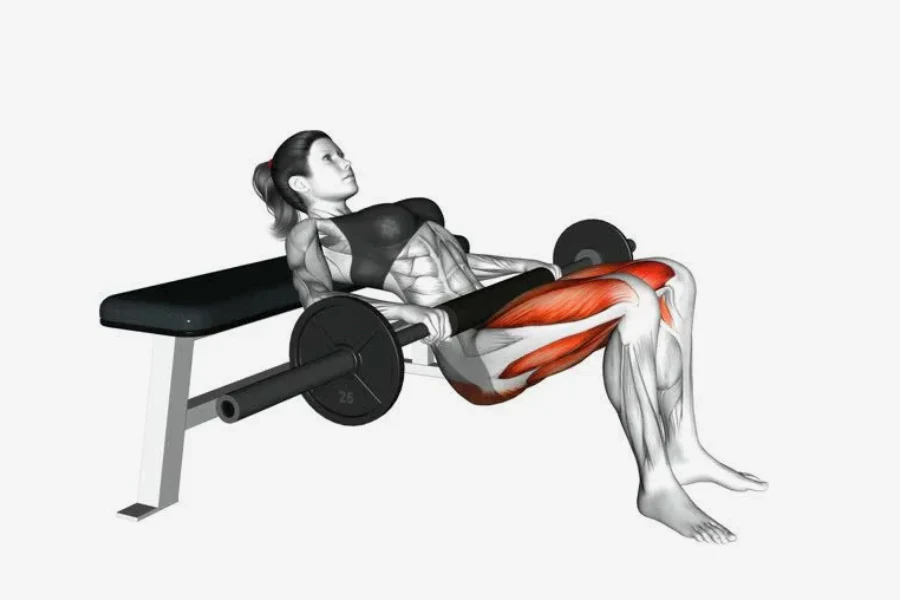Hip thrusts with barbells have become a popular exercise for building and toning glute muscles, and for good reason.
This compound exercise targets the glutes, hamstrings, and lower back, making it an effective way to build strength and increase muscle mass. However, it’s important to learn how to execute this exercise with proper form to avoid injury and ensure maximum results.
In this guide, we will provide you with a step-by-step breakdown of how to perform a hip thrust with a barbell. We’ll also cover common mistakes to avoid and tips for improving your form.
Whether you’re a beginner or an experienced lifter, this guide will help you build a stronger, firmer, and more toned backside. So, grab your barbell, and let’s get started!
Proper Set Up and Execution of Hip Thrust with Barbell
Barbell hip thrusts involve pushing a loaded barbell up and off the ground by extending your hips into a bridge position.
It is important to begin with a proper set-up when performing hip thrusts with a barbell. In this section, we will discuss the correct form and execution of the exercise.
Choosing the appropriate weight for your fitness level
Choosing the appropriate weight for your fitness level is key to properly executing hip thrusts with a barbell.
Beginners should start off with light weights and slowly increase the weight as their strength and technique improve over time.
When selecting a weight for hip thrusts, keep in mind that you should be able to complete 8–12 reps without feeling overwhelmed or fatigued. If you are struggling to complete the exercise with a certain weight, select a lighter weight.
Positioning the barbell correctly on your hips
Positioning the barbell correctly on your hips is essential for performing hip thrusts with a barbell correctly.
Begin by lying flat on your back and placing the barbell across your hips. Be sure to keep your feet firmly planted on the ground, ideally shoulder-width apart, and make sure that the barbell is placed in line with your body.
It should not be too far forward or too far back.
From this starting position, you will then push your feet into the ground and thrust your hips upward towards the ceiling. Be sure to keep your torso flat throughout the motion and engage your core muscles to help stabilize and support your body.
Placing your feet and knees in the proper position
Placing your feet and knees in the proper position is essential for performing hip thrusts with a barbell correctly.
Begin by positioning your feet shoulder-width apart, parallel to your hips. Make sure that your toes are pointed slightly outward and that your knees are bent at a 90-degree angle.
It is important to keep your feet firmly planted on the ground throughout the exercise in order to maximize your results.
Engaging your glutes and core muscles throughout the movement
As you push your hips upwards, be sure to squeeze your glutes and engage your core muscles in order to stabilize and support your body.
This will help you generate more power and achieve better results from the exercise. Additionally, it will also help to prevent injury by engaging the right muscles throughout the movement.
Lowering the barbell in a controlled fashion
After you have pushed your hips up to their peak position, be sure to slowly lower the barbell back down to the starting position.
Be sure to keep your core and glutes engaged throughout the motion and resist the urge to drop the weight too quickly. This will help you to maximize your results and prevent injury.
Pushing your hips up and squeezing your glutes at the top of the movement
As you push your hips up towards the ceiling, be sure to squeeze your glutes as tightly as possible.
This will help to maximize the tension on the muscles and ensure that you are engaging them throughout the exercise. Additionally, it will help to target the right muscles and ensure that you are getting the most out of your hip thrusts with a barbell.
Releasing the tension in your muscles after completing each rep
It is important to release the tension in your muscles after completing each rep of the hip thrusts with a barbell.
After pushing your hips up and squeezing your glutes at the top of the movement, slowly lower the barbell back to its starting position.
Once you have reached the starting position, be sure to relax your glutes and core muscles in order to allow them to recover before performing the next rep. This will help to maximize your results and prevent injury.
Now that you have learned about the proper set up and execution of hip thrusts with a barbell, the next thing that’s important to understand is, what are some common mistakes to avoid when doing hip thrusts with a barbell.
Common Mistakes to Avoid When Doing Hip Thrusts with Barbell
There are a lot of mistakes that people make when doing hip thrusts with a barbell. The most common ones are related to incorrect form, unwarranted weight, and failure to properly engage the muscles.
But let’s cover the most important thing you should remember.
Overarching your lower back
Overarching your lower back is a common mistake when performing hip thrusts with a barbell. This occurs when you allow your lower back to release too much tension and arch in an overly-extended position.
This can not only decrease the effectiveness of the exercise, but it can also put unnecessary strain on your spine and put you at risk for injury.
To prevent this from occurring, be sure to keep your core engaged, glutes squeezed, and back as flat as possible throughout the entire motion.
Incorrect foot placement
When setting up for the hip thrust with a barbell, it is important to have your feet shoulder-width apart and toes pointed slightly outward.
This helps to ensure that you are engaging the correct muscles and stabilizing your body throughout the entire movement.
Failure to engage the glutes and core muscles
It is important to make sure that you are engaging your glutes and core muscles during each hip thrust with a barbell.
Without proper engagement, you will not be able to maximize your results and put yourself at risk for injury. Be sure to squeeze your glutes and keep your core tight as you push your hips up toward the ceiling.
Using momentum to lift the weight instead of engaging your muscles
Using momentum to lift the weight instead of engaging your muscles is a common mistake when performing hip thrusts with a barbell. This occurs when you allow your body to swing and use momentum to lift the weight rather than engaging your core and glutes throughout the entire motion.
This can not only decrease the effectiveness of the exercise, but it can also put unnecessary strain on your spine and put you at risk for injury. To prevent this from happening, be sure to keep your core engaged, glutes squeezed, and back as flat as possible throughout the entire motion.
With this in mind, maybe you want to know about different variations and modifications for hip thrusts with barbell, so that will be the next section.
Variations and Modifications for Hip Thrust with Barbell
In order to maximize the effectiveness of your hip thrusts with a barbell, it is important to mix up your routine and incorporate various variations and modifications. Here are some of our favorites:
Single-leg hip thrusts for added challenge and balance
This variation is designed to increase the stability and proprioception required from the legs, glutes, core, and spine in order to balance on one leg.
To begin, lie on your back with your knees bent and your feet planted on the ground. From here, raise one leg up so that it is parallel with the ground.
Gently place a barbell across your hips, and then proceed to thrust your hips up towards the ceiling while keeping your core tight and your back flat. Be sure to squeeze your glutes at the top of the motion before slowly lowering back down.
Banded hip thrusts to increase resistance and activation in glutes
The use of bands during hip thrusts is a great way to increase the intensity and resistance of your exercise while also activating your glutes more effectively.
By adding a band around your thighs, you will be able to target your glutes more efficiently and get better results from the exercise.
To begin, set up for the exercise as you normally would. Once the band is in place and your hips are high, proceed to squeeze your glutes and push your hips forward at the same time.
This will create tension on the band and increase the difficulty of the exercise while also helping to activate your glutes more effectively.
Pause or tempo hip thrusts to increase time under tension and muscle engagement
Pause or tempo hip thrusts are a great way to increase the time under tension and muscle engagement during your exercise. This variation requires you to pause for a set amount of time at the top of the motion, allowing you to engage your muscles more effectively as you slowly lower back down.
To begin, set up for a standard hip thrust with a barbell as usual. Once in position, proceed to thrust your hips up towards the ceiling and pause at the top for a few seconds before slowly lowering them back down.
By pausing at the top, you will be able to increase the time under tension while also engaging your muscles more effectively throughout the entire motion.
Hip thrusts with a pad or cushion for added comfort and support
If you are looking for an extra bit of comfort and support while performing hip thrusts, then adding a pad or cushion to the exercise may be just what you need.
Using a pad or cushion will help to reduce the strain on your back, hips, and spine, as well as increase the effectiveness of the exercise.
To begin, set up for a standard hip thrust with a barbell as usual. Once in position, place the cushion or pad under your hips and shoulders before proceeding to thrust your hips up toward the ceiling.
By adding this extra bit of comfort and support, you will be able to get better results while also reducing the strain on your body.
We have covered a lot. After understanding the proper set up and execution of hip thrusts with barbell, common mistakes to avoid, and different variations and modifications, the last thing is to explain how you can add hip thrusts with barbell into your routine.
Incorporating Hip Thrust with a Barbell into Your Fitness Routine
Incorporating hip thrusts with a barbell into your fitness routine is a great way to strengthen and tone the muscles in your glutes and lower body. They can be done as part of a full-body workout or as an isolated exercise to target the glutes specifically.
Here’s how you can incorporate hip thrusts with a barbell into your fitness routine:
- Start by incorporating a few sets of hip thrusts with a barbell at the end of your lower body workout for 2-3 sets and 8-10 reps.
- Increase the weight of the barbell and the number of sets as you become stronger.
- Do 1-2 sets of paused or tempo hip thrusts at the beginning of your lower body workout to activate your glutes and get them ready for the rest of your exercises.
- Consider adding a pad or cushion to reduce strain on your back, hips, and spine while performing the exercise.
By following these tips, you will be able to get the most out of this exercise and see great results in no time.
Frequently Asked Questions
After reading through the information above, you may still have questions about mastering the hip thrust with a barbell. Here are some frequently asked questions about this exercise:
What muscles does the hip thrust with a barbell work?
The hip thrust with a barbell primarily works the gluteus maximus, gluteus medius, and gluteus minimus. This exercise also engages the hamstrings and core muscles to stabilize your body throughout the motion.
By incorporating hip thrusts into your routine, you will be able to strengthen and tone these important muscles for improved performance and better results.
Is the hip thrust with a barbell dangerous?
When done correctly, the hip thrust with a barbell is a safe exercise. To reduce your risk of injury, make sure to use proper form and start with lighter weights before gradually increasing the weight as you become stronger. Additionally, consider using a pad or cushion for added comfort and support while performing this exercise.
How much weight should I use for the hip thrust with a barbell?
When starting out, it is best to choose a light weight that will allow you to focus on proper form and technique. Once you have the form down, you can gradually increase the weight as you become stronger.
You can use heavy weights for the hip thrust with a barbell, but it is important to make sure that you can still maintain proper form throughout the exercise before increasing the weight.
How often should I incorporate the hip thrust with a barbell into my workout routine?
The frequency at which you should perform hip thrusts with a barbell depends on your fitness goals and individual needs. If you are looking to strengthen and tone your glutes, then it is recommended that you incorporate hip thrusts into your routine 3-4 times a week. For best results, aim for 8-10 reps and 2-3 sets per session.
Can the hip thrust with a barbell help improve my athletic performance?
Yes, the hip thrust with a barbell can help improve your athletic performance. This exercise is great for strengthening and toning the glutes, which are important for powerful movements like sprinting, jumping, and agility drills.
The hip thrusts with a barbell also engage the core muscles to stabilize your body throughout the motion, which will help increase balance and coordination. This exercise can also help reduce the risk of injury by building strength in the lower body.
Are hip thrusts with a barbell better than squats for glute growth?
Hip thrusts with a barbell and squats both work to target the glutes and strengthen the lower body.
However, hip thrusts with a barbell may be more effective for glute growth compared to squats. The range of motion that hip thrusts allow is greater than that of squats, which can lead to increased glute activation and muscle growth.
Additionally, hip thrusts with a barbell can be used to overload the glutes more effectively than squats, allowing for greater muscular gains.
Conclusion
The hip thrust with a barbell is a great exercise for targeting the glutes, hamstrings, and lower back muscles.
To master this exercise, it’s important to choose the right weight, maintain proper form, and gradually increase the weight over time.
You should aim to incorporate the hip thrust with a barbell into your workout routine at least once a week and consider modifying the exercise if you have limited mobility.
Additionally, incorporating the hip thrust with a barbell into your workout routine can help improve your athletic performance, particularly for activities that involve explosive movements and lower body strength.
With the right technique and consistency, you can master the hip thrust with a barbell and see improvements in your overall fitness.





